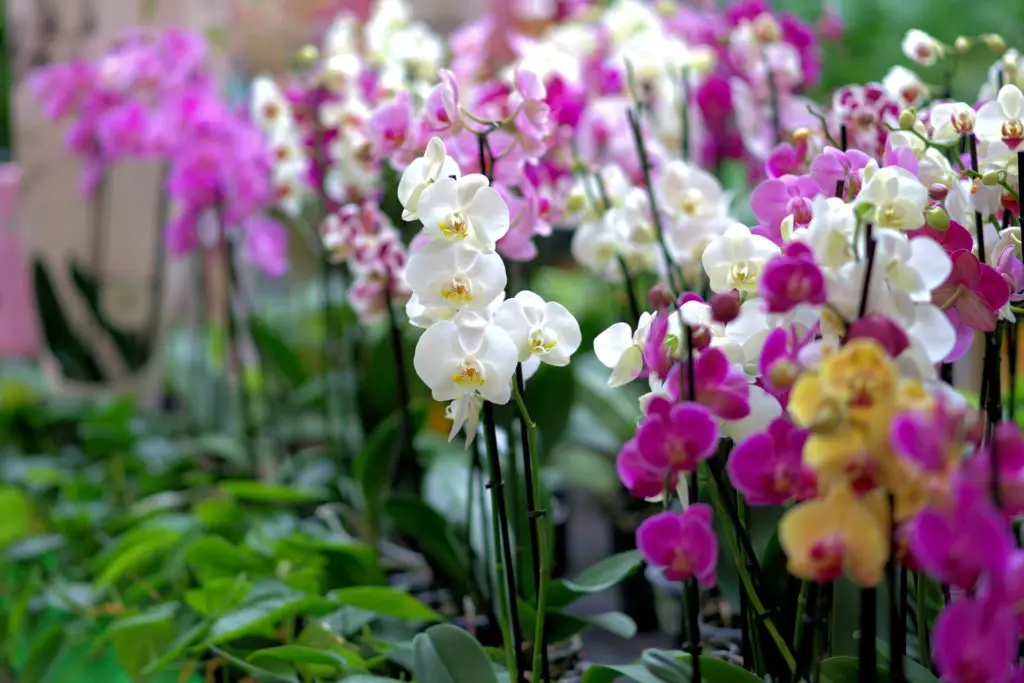Seeing orchids in the wild is literally connecting to nature. For its beautiful flowers, symmetrical shapes, and how it interacts with other beings in the wild.
Most wild orchids species are native to tropical and subtropical forests in Africa, Asia, south and central Americas. Orchids is one of the biggest plant families.
The orchid family consists of over 25,000 species and around 110,000 registered hybrids. Those are the registered numbers. Some orchids are not discovered nor registered. They are hiding in wilds that you can not imagine.

Types of orchids in the wild
wild orchids are primarily classified according to their preferred growing medium (Hosts) into three main categories: epiphytes, Terrestrials, and Lithphytes.
Epiphytes orchids
The word epiphytes in greeks means “on a top plant”. Most orchids that can be found in the wild are epiphytes. Epiphytes orchids are native to tropical and subtropical forests. Where the climate is humid and the forest covered with a closed canopy.
what distinguishes epiphytes orchids from the two other types is that they grow in the trees’ trunks.
They use their strong roots to anchor themselves in the forest trees. While those types of orchids stick themselves in the trunks they do not depend on the tree as a nutrient source (not a parasitic plant).
Such orchids take advantage of the moisture and nutrients in the form of decaying organic matters found in the tree barks crevices.
but mainly they get their moisture and nutrients from the air. And it makes sense since the tropical forests have humid air.
epiphytes orchids get their moisture and nutrients from the air through their thick aerial roots. Their roots absorb both moisture and food besides sticking the plant on the host tree.
How epiphytes orchids position themselves on the trees
In the tropical wilds epiphytes orchids can be found either on the top of the host tree trunk. Or on the lower part of the trunk or even in the lower branches.
Orchids position themselves on the tree according to their need for light. The ones you find on the top of the trunk are the species that need and tolerate more sunlight.
While orchids that found on the lower part of the trunk are the ones that need and can handle a low amount of sunlight exposure.
If you had a walk in the rainforest with an open eye. You may notice a group of orchids pick a certain side of the trunk to use it as a host.
If you analyzed this site you will find that the picked side provides the orchids with the exact conditions it needs.
Terrestrials orchids
Terrestrial is derived from the Latin word ” terra”. Which means earth. Those types of orchids grow in the ground ( soil is its growing medium).
Most orchids that can be found in the United States wilds are terrestrials. The roots of these orchids produce tubers to store in them moisture and nutrients. The plant uses the stored resources during the dry season.
Most terrestrials are deciduous plants. They discard their leaves and flowers and go dormant to survive the dry season.
you can see terrestrials orchids growing in the wild either as individual plants or in groups.
Lithophytes orchids
lithophytes word is derived from a greek word, which means “Stone”. Most lithophytes orchids can be found in the tropical wilds.
They use rocks as host objects. Such orchid gets its nutrients and moisture from the organic debris and moss found in the hosting rock crevices.
But mainly these orchids get its nutrients and moisture from the air through its strong roots similar to epiphytes orchids.
lithophytes orchids have fleshy leaves which it uses to store moisture to survive the dry season.
Sometimes, orchids living in the wild can adopt a lifestyle that is contrary to the nature of their type.
For example, if epiphytes fall from the tree trunk into the ground, it may adapt and live in the ground as terrestrial.
And vice versa if terrestrial orchid growing near the tree may grow in the trunk and adopt epiphytes style.
likewise, both epiphytes and terrestrial orchids may grow as lithophytes. In case there are enough moisture and nutrients in the hosting stone.
The life of orchids in the wild
The way orchids live in the wild is phenomenal. Starting from finding the right growing medium, why it has certain colors and scents. And the way it uses its physical attraction to survive in the wild.
Pollination
The act of pollination motivates the release of a certain chemical. This chemical directs the plant’s energy and resources from other plant activities to seed production.
The wilting bloom of the orchids flower is the first sign that the pollination process has started.
Seed formation and germination
After pollination has taken place seeds start to form in capsule behinds the orchids flowers. One of the things that common between all types of orchids is their massive seeds production.
Depending on the orchid type. It can take from a few weeks up to a year for the orchids seed to mature.
For epiphytes orchids the massive number of seeds matter. Because it helps the plant to have a better chance to set its seeds in the right places in order to propagate.
Since the relatively heavy seeds will fall into the ground. Which is not the preferable growing medium for epiphytes orchids. Only lightweight and fine orchid seeds will be airborne.
Those are the seeds with better chances to end up in a spot in the tree trunk that is a suitable environment for germination and growth.
Terrestrial orchids require specific soil requirements. Therefore the massive number and widespread of the seeds increase the chance of a few numbers of orchid seeds lands on the right soil.
Orchids lack endosperm. It is the substance found in most plants seeds. the endosperm provides the seed with the required energy to germinate. Therefore orchids need fungus to germinate.
There are epiphytes and common soil fungus. Those different types of fungus help different types of orchids to germinate.
In order for an orchid seed to succeed it has to land near fungus. And the location should also have enough moisture and nutrients ( in the form of decaying organic matters).
Orchids Scent and color
Wild orchids have different ranges of colors and scents. Some orchids have delightful odors with a hint of chocolate and coconut smell. Others have musty scents.
Orchids emit scents through special glands usually located on the lip. Wild orchids use their scents to attract specific pollinators. Each type may demand specific insects to work as a pollinator.
Therefore the specific odors emitted by orchids attract specific pollinators. For example, most orchids that emit sweet fragrances are intending to attract bees.
While the ones that emit nasty scents intending to attract some kind of moths.
The process of fragrance emission is an energy-consuming process. Therefore wild orchids evolved to only produce and emits those fragrances during the active period of the preferred pollinator.
For example, Cattley Luteola (one of the orchids type) is a bee-pollinated flower, emits attractive fragrances during the early morning when bees are active. While it has no scent at night.
On the other hand, Angraecum species which are moth- pollinated orchids produce and emits intensive fragrance in the night when moths are active. And no to little scents in the day time when moths are inactive.
Also, the colors of the orchids work as an attractive factor for pollinators. The specific colors are designed to be more visually appealing to specific insects.
Wild orchids deceive other beings
Mimicry is the process in which some species evolved to resemble and mimic other species. Wild orchids have developed a complex combination of scents, colors, and designs to mimic certain species and objects in order to attract specific pollinators.
Some orchids developed flower design, colors, and fragrance that mimic the female of certain bee species. The bee male of this species seeks the females in the time of reproduction. Guess what! orchids bloom in the same period to mimic the female bee. it is not a coincidence.
The orchids show itself as a suitable target for those male bees (as a female bee). The fooled male engages the flower in copulation( more specifically this act called pseudocopulation).
This process does the male bee no good in terms of its species propagation. But it ensures the pollination of those specific species of wild orchids. what a deceptive plant!
Other types of wild orchids that they prefer to be pollinated by flies have evolved to emit musty scents to mimic some type of fungus. Flies use that fungus as a home for their eggs.
This wild orchids species beside emitting the musty scents, they also have the shape and color of rotting flesh. This trick fools the fly to get into the flower in search of a home to its eggs and nutrients supply.
While the fly explores the flower it touches the flower’s reproductive parts which will cause the pollination.
Saving the orchids growing in the wild
Most probably after you read the previous sections of this article you understand how orchids require specific and rare conditions to survive. While nature can sustain itself. Human behavior toward nature had led a lot of orchids species to the danger of extinction.
There are many reasons why orchids are endangered species. But climate change, excessive logging, the collection of orchids from the wild, and destroying their natural habitats to build new communities are the main reasons.
All orchids are protected by CITES ( the Convention on International Trade in Endangered species of Flora and Fauna).
This international agreement protects plants and animals in which the international trade of these plants or animals affects their survival in their native habitat.
In most countries which orchids grow in its wilds, It is illegal to pick orchids from the wild.
